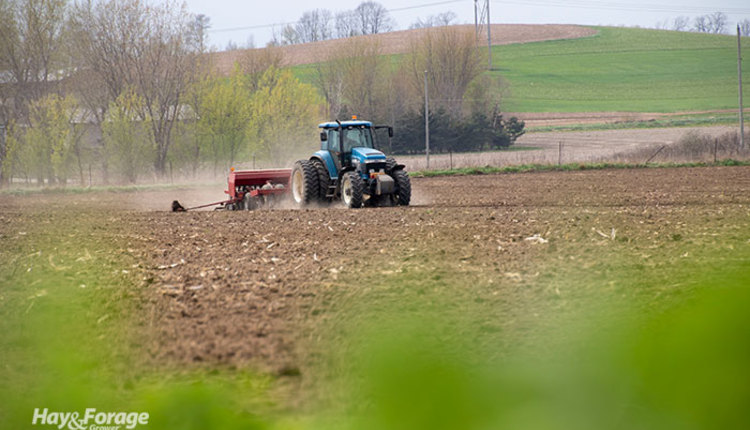Ten steps for a successful new seeding |
| By Hay and Forage Grower |
|
|
 For many forage producers, spring is a preferred seeding time or is perhaps the only time of year when land is available to establish new stands. When making spring forage seedings, earlier is generally better than later. “As planting is delayed, the risk of a failed stand increases because of more competition from weeds. Also, young seedlings are more prone to drying out under the summer heat,” explains Mark Sulc, a forage agronomist with Ohio State University Extension. In a recent issue of Buckeye Dairy News, Sulc outlined 10 steps that are key to realizing a successful spring-seeded forage stand. 1. Ensure soil pH and fertility are within recommended ranges. “Forages are more productive where soil pH is above 6, but for alfalfa it should be 6.5 to 6.8,” Sulc notes. “If seedings are to include alfalfa, and soil pH is not at least 6.5, it would be best to apply lime now, plant an annual grass forage this spring, then delay establishing alfalfa until late summer.” 2. Plant high-quality seed. Know that your seed is from a reputable source. Saving a few dollars to plant “variety not stated” seed often proves to be a poor investment because of lower yields and a shorter stand life. 3. Seed early. Although sometimes easier said than done, Sulc recommends that seedings be made as soon as the soil conditions allow. This gives both the new seeding a jump on weeds and allows for an established root system by the time hot, dry weather hits during summer. Later seedings also yield less than earlier ones. 4. Plant into a good seedbed. “The ideal seedbed for conventional seedings is smooth, firm, and weed-free,” Sulc says. “Don’t overwork the soil. Too much tillage depletes moisture and increases the risk of surface crusting.” No-till seedings are appropriate on silt-loam soils where the surface residue is more than 35% and there is good drainage. 5. Calibrate the drill or seeder. Seed output can vary with the species and variety planted. Seed coatings will also impact seed flow through the drill. Instructions for calibrating a drill can be viewed in this video from the University of Kentucky. 6. Don’t plant too deep. “Plant seed shallow, about 1/4 to 1/2-inch deep and in good contact with the soil,” Sulc notes. “Stop and check the actual depth of the seed in the field when you first start planting. This is especially important with no-till drills. In my experience, seeing some seed on the surface indicates most of the seed is about at the right depth,” he adds. 7. Use press-wheel drills in a conventionally prepared seedbed. If using a drill with press wheels, or if broadcasting seed, Sulc recommends to cultipack before and after seeding. 8. Companion crop or not? Direct seeding without a companion crop will offer more high-quality forage in the seeding year, especially if alfalfa is being established. On erosion-prone fields or those easily crusted, a small grain companion crop may be the best choice. “Companion crops usually increase total forage tonnage in the seeding year, but forage quality will be lower than direct-seeded legumes,” Sulc explains. “Use an early maturing, short, and stiff-strawed small grain variety; plant companion small grains at 1.5 to 2 bushels per acre; remove the companion crop for early pasture or silage; and do not apply additional nitrogen to the companion crop,” he recommends. 9. Scout new seedings for weeds and insects. Weed competition can be devastating to a new forage seeding during the early stages of plant development. Later, potato leafhoppers can cause permanent injury to new alfalfa stands. 10. Delay first cutting. “The first harvest of the new seeding should generally be delayed until early flowering of legumes, unless weeds were not controlled adequately and are threatening to smother the stand,” Sulc notes. “For pure grass seedings, harvest after 70 days from planting. If weeds are encroaching, clip the field to prevent seedhead development.” |
